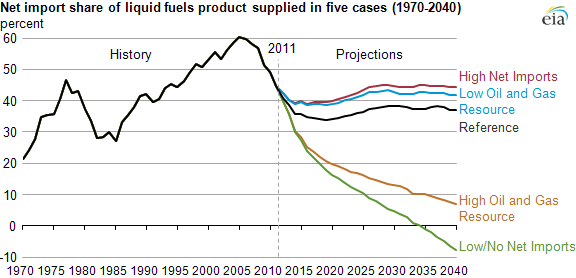
Abundant U.S. supply, low demand could cut dependence on liquid fuel imports

U.S. net imports of petroleum and other liquid fuels as a share of product supplied (used as a proxy for consumption) have been one of the most watched indicators in national and global energy analyses. The Annual Energy Outlook 2013 includes a case in which net imports of liquid fuels are eliminated by 2035 under inherently speculative assumptions that boost supply and reduce demand relative to the previously published Reference case.
The Low/No Net Imports case simulates an environment in which U.S. energy production grows rapidly while domestic consumption of liquid fuels declines. The Low/No Net Imports case assumes that more petroleum can be recovered from tight oil formations as well as from offshore, Alaska, and gas-to-liquids sources than is considered achievable using current technology and known geology. Domestic crude oil production approaches 10 million barrels per day by 2020 and is sustained near or above that level through 2040.
In the Low/No Net Imports case, assumptions limit growth in demand for liquid fuels. Projected liquid fuels demand is assumed to be lowered by technological, economic, and behavioral factors including:
- Light-duty vehicle technology is improved
- Vehicle fuel efficiency standards are tightened beyond the 2025 model year
- Electric vehicle batteries are improved
- Natural gas market penetration into the freight transport industries is expanded
- Growth in vehicle miles traveled is significantly reduced relative to the Reference case
Additional analysis of the Low/No Net Imports case and related Import Dependence side cases can be found in the full Annual Energy Outlook 2013.